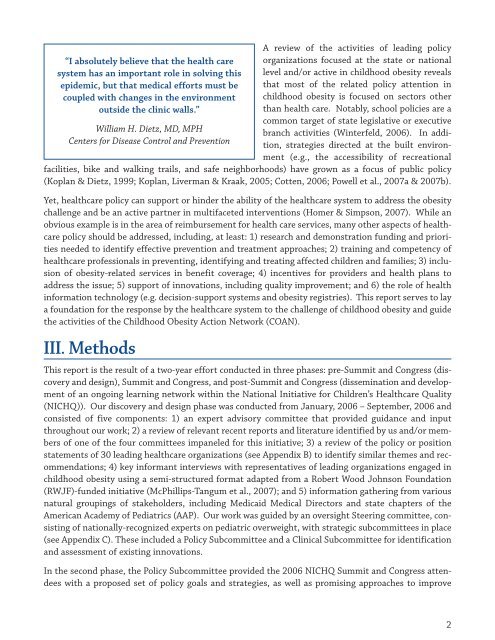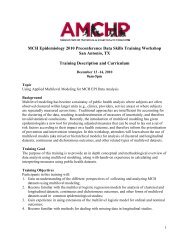Childhood Obesity: The Role of Health Policy - Association of ...
Childhood Obesity: The Role of Health Policy - Association of ...
Childhood Obesity: The Role of Health Policy - Association of ...
You also want an ePaper? Increase the reach of your titles
YUMPU automatically turns print PDFs into web optimized ePapers that Google loves.
“I absolutely believe that the health care<br />
system has an important role in solving this<br />
epidemic, but that medical efforts must be<br />
coupled with changes in the environment<br />
outside the clinic walls.”<br />
William H. Dietz, MD, MPH<br />
Centers for Disease Control and Prevention<br />
A review <strong>of</strong> the activities <strong>of</strong> leading policy<br />
organizations focused at the state or national<br />
level and/or active in childhood obesity reveals<br />
that most <strong>of</strong> the related policy attention in<br />
childhood obesity is focused on sectors other<br />
than health care. Notably, school policies are a<br />
common target <strong>of</strong> state legislative or executive<br />
branch activities (Winterfeld, 2006). In addition,<br />
strategies directed at the built environment<br />
(e.g., the accessibility <strong>of</strong> recreational<br />
facilities, bike and walking trails, and safe neighborhoods) have grown as a focus <strong>of</strong> public policy<br />
(Koplan & Dietz, 1999; Koplan, Liverman & Kraak, 2005; Cotten, 2006; Powell et al., 2007a & 2007b).<br />
Yet, healthcare policy can support or hinder the ability <strong>of</strong> the healthcare system to address the obesity<br />
challenge and be an active partner in multifaceted interventions (Homer & Simpson, 2007). While an<br />
obvious example is in the area <strong>of</strong> reimbursement for health care services, many other aspects <strong>of</strong> healthcare<br />
policy should be addressed, including, at least: 1) research and demonstration funding and priorities<br />
needed to identify effective prevention and treatment approaches; 2) training and competency <strong>of</strong><br />
healthcare pr<strong>of</strong>essionals in preventing, identifying and treating affected children and families; 3) inclusion<br />
<strong>of</strong> obesity-related services in benefit coverage; 4) incentives for providers and health plans to<br />
address the issue; 5) support <strong>of</strong> innovations, including quality improvement; and 6) the role <strong>of</strong> health<br />
information technology (e.g. decision-support systems and obesity registries). This report serves to lay<br />
a foundation for the response by the healthcare system to the challenge <strong>of</strong> childhood obesity and guide<br />
the activities <strong>of</strong> the <strong>Childhood</strong> <strong>Obesity</strong> Action Network (COAN).<br />
III. Methods<br />
This report is the result <strong>of</strong> a two-year effort conducted in three phases: pre-Summit and Congress (discovery<br />
and design), Summit and Congress, and post-Summit and Congress (dissemination and development<br />
<strong>of</strong> an ongoing learning network within the National Initiative for Children’s <strong>Health</strong>care Quality<br />
(NICHQ)). Our discovery and design phase was conducted from January, 2006 – September, 2006 and<br />
consisted <strong>of</strong> five components: 1) an expert advisory committee that provided guidance and input<br />
throughout our work; 2) a review <strong>of</strong> relevant recent reports and literature identified by us and/or members<br />
<strong>of</strong> one <strong>of</strong> the four committees impaneled for this initiative; 3) a review <strong>of</strong> the policy or position<br />
statements <strong>of</strong> 30 leading healthcare organizations (see Appendix B) to identify similar themes and recommendations;<br />
4) key informant interviews with representatives <strong>of</strong> leading organizations engaged in<br />
childhood obesity using a semi-structured format adapted from a Robert Wood Johnson Foundation<br />
(RWJF)-funded initiative (McPhillips-Tangum et al., 2007); and 5) information gathering from various<br />
natural groupings <strong>of</strong> stakeholders, including Medicaid Medical Directors and state chapters <strong>of</strong> the<br />
American Academy <strong>of</strong> Pediatrics (AAP). Our work was guided by an oversight Steering committee, consisting<br />
<strong>of</strong> nationally-recognized experts on pediatric overweight, with strategic subcommittees in place<br />
(see Appendix C). <strong>The</strong>se included a <strong>Policy</strong> Subcommittee and a Clinical Subcommittee for identification<br />
and assessment <strong>of</strong> existing innovations.<br />
In the second phase, the <strong>Policy</strong> Subcommittee provided the 2006 NICHQ Summit and Congress attendees<br />
with a proposed set <strong>of</strong> policy goals and strategies, as well as promising approaches to improve<br />
2



